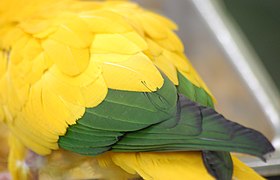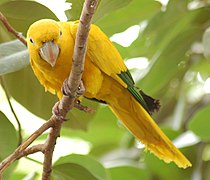Golden parakeet
| Golden parakeet | |
|---|---|

| |
| At Gramado Zoo, Brazil | |
| Scientific classification | |
| Kingdom: | Animalia |
| Phylum: | Chordata |
| Class: | Aves |
| Order: | Psittaciformes |
| Family: | Psittacidae |
| Genus: | Guaruba Lesson, 1830 |
| Species: | G. guarouba
|
| Binomial name | |
| Guaruba guarouba (Gmelin, 1788)
| |

| |
| Synonyms | |
|
Psittacus guarouba | |
The golden parakeet or golden conure,[2] (Guaruba guarouba), is a medium-sized golden-yellow Neotropical parrot native to the Amazon Basin of interior northern Brazil.
Its plumage is mostly bright yellow, hence its common name, but it also possesses green remiges.[3] It lives in the drier, upland rainforests in Amazonian Brazil, and is threatened by deforestation and flooding, and also by the now-illegal trapping of wild individuals for the pet trade.[4] It is listed on CITES appendix I.[5]
German naturalist Georg Marcgraf first described the bird, called guaruba in his expedition to Dutch Brazil in 1638.[6] Its Portuguese and indigenous name, ararajuba, means small yellow macaw. In aviculture, it is sometimes known as the Queen of Bavaria conure.[7]
Taxonomy[]
Formerly classified as Aratinga guarouba [Notes 1], it is now a species in the monotypic genus Guaruba,[8][9][10] one of numerous genera of New World long-tailed parrots in tribe Arini, which also includes the Central and South American macaws. Tribe Arini together with the Amazonian parrots and a few miscellaneous genera make up subfamily Arinae of Neotropical parrots in family Psittacidae of true parrots.[11]
The specific name guarouba (alternately guaruba) is derived from Old Tupi: guará, "small bird"; and Old Tupi: yuba, "yellow"; hence "small yellow bird".[12] The different spellings of the genus and species names result from the different spellings used by Lesson and Gmelin when they postulated the taxa. The taxonomic convention is to retain the names as spelled by the original authorities.[13]
Molecular studies show that Guaruba and Diopsittaca (red-shouldered macaw) are sister genera.[14][15][16][17] It is also closely related to Leptosittaca branicki, (golden-plumed parakeet).
Description[]
The golden parakeet is 34 cm (13 in) long [18] and mainly yellow with green in the outer wings and with an all-yellow tail. It has a large horn-colored (gray) beak, pale-pink bare eye rings, brown irises, and pink legs. Males and females have identical external appearance. Juveniles are duller and have less yellow and more green plumage than the adults. The juvenile's head and neck are mostly green, the back is green and yellow, the upper side of tail is mostly green, the breast is greenish, the eye rings are pale-gray, and the legs are brown.[19]
Distribution and habitat[]
Its range is estimated to be limited to about 174,000 km2.[18] between the Tocantins, lower Xingu, and Tapajós Rivers in the Amazon Basin south of the Amazon River in the state of Pará, northern Brazil. Additional records occur from adjacent northern Maranhão. The birds in a 1986 study used two different habitats during the year; during the nonbreeding season, which coincided with the dry season, they occupied the tall forest. During the breeding season, they left the tall forest and entered open areas on the edge of the forest such as fields used in agriculture.[20]
Behavior[]
Golden parakeets are a social species, living, feeding, sleeping, and even breeding together.[20] In the wild, they have a varied diet, feeding on fruits such as mango, muruci and açai, flowers, buds, seeds (including , and crop plants, particularly maize.[18][21]
Reproduction[]

The golden parakeet's breeding system is almost unique amongst parrots, as pairs are aided by a number of helpers which aid in the raising of the young.[20] This behavior is less common with parakeets in captivity, which often abandon their young after three weeks.[4]
After the golden parakeet reaches sexual maturity at the age of three years, the breeding season starts in November and runs through February. They nest in a high tree, in deeper than average nesting cavities, and lay an average of four 37.1 by 29.9 mm (1.46 by 1.18 in) white eggs, which they aggressively guard. The incubation period is about 30 days, in which the male and female take turns incubating. In the first few years of sexual maturity, golden parakeets tend to lay infertile clutches until the age of six to eight. In captivity, golden parakeets resume breeding when their chicks are taken from them.[4][22]
At birth, golden parakeets are covered in white down that eventually turns darker within a week. By the end of the third week, wing feathers start to develop. Juveniles are playful, but may turn abusive against their peers.[4] Nestlings are preyed upon by toucans, which may explain their social behavior. Nests are vigorously defended from toucans by several members of the group.[20]
Conservation and threats[]
The golden parakeet is listed on the IUCN Red List as vulnerable.[1] This is largely due to deforestation and the capture of wild birds for aviculture, where it is in high demand due to the attractiveness of its plumage. Locally, they are considered as pests for feeding on crops, and are hunted for food or sport.[4] The current population is estimated to be in the range of 10,000 to 20,000.[18][23]
An example of the displacement of golden parakeets by habitat loss comes from the building of the Tucuruí Dam, Pará, from 1975–1984. More than 35,000 forest dwellers were forced from what had been a habitat that was considered to be "among the richest and most diversified in the world." In addition, 2,875 km2 (1,110 sq mi) of rainforest were flooded, and 1,600 islands were produced by the flooding, all of which were heavily deforested.[24]
An international effort led by the Brazilian government in partnership with Parrots International, Lymington Foundation, the University of São Paulo and others is underway to raise young birds in captivity reintegrate them to their natural habitat with support of locals in Northeast Brazil.[25]
Gallery[]

Queen of Bavaria's Parrot

Feeding in captivity at the National Aviary

Closeup of the head

Closeup of the tail

Closeup of green outer wing

At the National Aviary

Golden Parrot

At Walsrode Bird Park

Guaruba guarouba, Bird Park of Foz do Iguaçu, Brazil
See also[]
Notes[]
- ^ SACC 2005: 6. Guarouba was formerly (e.g., Peters 1937, Meyer de Schauensee 1970) included in Aratinga, but see Sick (1990), and also Tavares et al. (2004, 2006), Wright et al. (2008), and Kirchman et al. (2012), whose genetic data indicated that the sister genus to Guarouba is Diopsittaca, thus forcing a return to earlier classifications (e.g., Cory 1918, Pinto 1937) that treated it in a monotypic genus.
References[]
- ^ Jump up to: a b BirdLife International (2013). "Guaruba guarouba". IUCN Red List of Threatened Species. 2013. Retrieved 26 November 2013.
- ^ Zipcode Zoo URL accessed January 24, 2007.
- ^ Golden Palms - Golden Conure Archived 2007-08-16 at the Wayback Machine URL accessed January 26, 2007.
- ^ Jump up to: a b c d e Honolulu Zoo Archived 2007-03-06 at the Wayback Machine URL accessed January 24, 2007.
- ^ "Species lists (Appendices I, II and III)". CITES. 1 July 2008. Archived from the original on 29 December 2007.
- ^ Marcgraf, Georg (1648). Historia Naturalis Brasiliae. Willem Piso.
- ^ Aratinga guarouba Archived 2007-01-24 at the Wayback Machine URL accessed January 26, 2007.
- ^ Collar, Nigel (2000). Threatened Birds of the world. Birdlife International. p. 261.
- ^ Sick, Helmut (1990). "Notes on the Taxonomy of Brazilian Parrots". Ararajuba (1): 111–112.
- ^ "Zoological Nomenclature Resource: Psittaciformes (Version 9.022)". www.zoonomen.net. 2009-04-02.
- ^ "TiF Checklist: BASAL AUSTRALAVES: Cariamiformes, Falconiformes & Psittaciformes". jboyd.net.
- ^ Jobling, James (2009). Helm Dictionary of Scientific Bird Names. Christopher Helm Publishers Ltd.
- ^ "International Code of Zoological Nomenclature". Retrieved 22 December 2013.
- ^ Tavares, Erika; Yamashita, Miyaki (Jan 2004). "Phylogenetic Relationships Among Some Neotropical Parrot Genera Based on Mitochondrial Sequences". The Auk. 121 (1): 230–242. doi:10.1642/0004-8038(2004)121[0230:prasnp]2.0.co;2.
- ^ Tavares, Erika (2006). Baker, A.J., Pereira, S.L., & Miyaki, C.Y. "Phylogenetic relationships and historical biogeography of Neotropical parrots (Psittaciformes: Psittacidae: Arini) inferred from mitochondrial and nuclear DNA Sequences". Systematic Biology. 55: 454–470. doi:10.1080/10635150600697390. PMID 16861209.
- ^ Wright, Timothy; et al. (2008). "A multilocus molecular phylogeny of the parrots (Psittaciformes): support for a Gondwanan origin during the Cretaceous". Molecular Biology and Evolution. 25: 2141–2156. doi:10.1093/molbev/msn160. PMC 2727385. PMID 18653733.
- ^ Kirchman, J.; Schirtzinger, Wright (April 2012). "Phylogenetic relationships of the extinct Carolina Parakeet inferred from DNA sequence data". The Auk. 129 (2): 197–204. doi:10.1525/auk.2012.11259.
- ^ Jump up to: a b c d "Birdlife International Species Factsheet".
- ^ Forshaw, Joseph M. (2006). Parrots of the World; an Identification Guide. Illustrated by Frank Knight. Princeton University Press. Plate 74. ISBN 0-691-09251-6.
- ^ Jump up to: a b c d Oren, David C.; Novaes, Fernando (1986). "Observations on the golden parakeet Aratinga guarouba in Northern Brazil". Biological Conservation. 36 (4): 329–337. doi:10.1016/0006-3207(86)90008-X.
- ^ "Natural Diet". goldenconure.org. Retrieved 24 January 2007.
- ^ Golden Conure - Breeding URL accessed January 26, 2007.
- ^ Laranjeiras, Thiago (Sep 2011). "Biology and population size of the Golden Parakeet (Guaruba guarouba) in western Pará, Brazil, with recommendations for conservation" (PDF). Revista Brasileira de Ornitologia. 19 (3): 303–314. Archived from the original (PDF) on 2013-12-14.
- ^ Deforestation URL accessed January 26, 2007.
- ^ [1] Fundacao Lymington Sao Paulo URL accessed August 13, 2017.
External links[]
- Species factsheet at BirdLife International
- IUCN Red List vulnerable species
- Parakeets
- Birds of the Amazon Basin
- Birds of Brazil
- Birds described in 1788
- Taxa named by Johann Friedrich Gmelin










